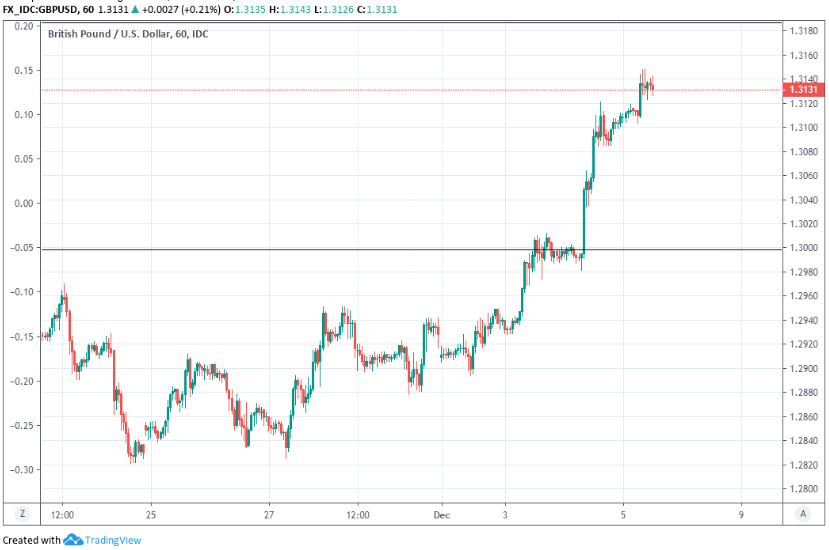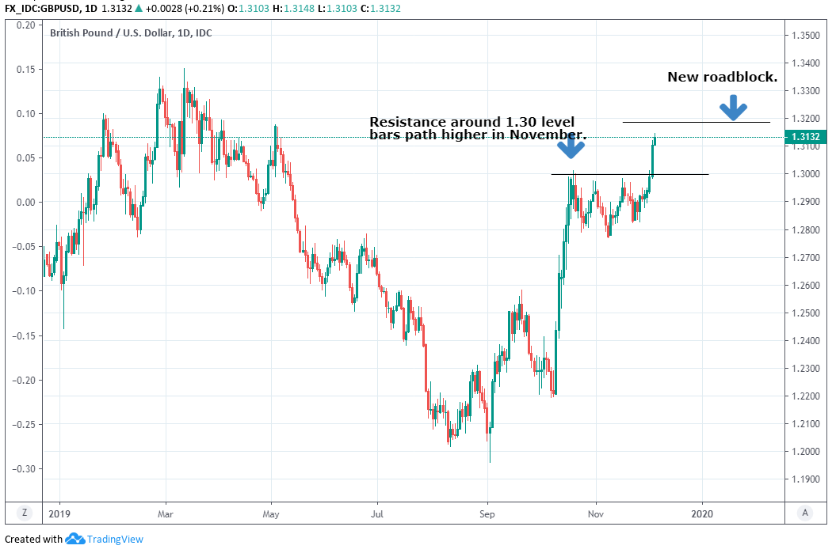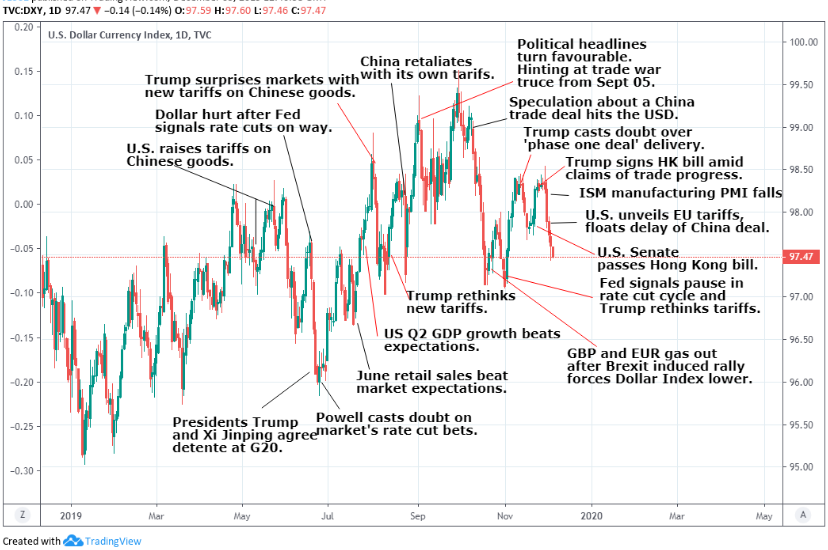Pound-Dollar Aided by Conservative Poll Gains, Brexit Party Resignations, but Roadblocked on Charts
- Written by: James Skinner

© IRStone, Adobe Stock
- GBP/USD advances further after clearing 1.30 resistance level.
- Amid Conservative Party poll gains and Brexit Party resignations.
- Markets cheer Tory lead, but another technical roadblock is ahead.
- Commerzbank tips failure at major trendline and retracement-level.
- But fundamental analysts see new 1.30-1.34 range for GBP/USD.
The Pound topped the major currency league table again Thursday amid further suggestions Prime Minister Boris Johnson maintains a comfortable polling lead ahead of next week's election, although Commerzbank is tipping "failure" for the Pound-Dollar rate near to current levels.
Prime Minister Boris Johnson is on course for a comfortable parliamentary majority next Saturday, many pollsters are suggesting and the market is taking them seriously. Overnight, a new poll from ComRes suggested the Conservatives have 42% of the popular vote against Labour's 32%, while seat projections based on a margin of 10 points have shown the Conservatives winning a comfortable majority.
The polls came earlier in a session that also saw four high-profile Brexit Party MEPs resign before advocating that supporters back Johnson and his party in the election. John Longworth, Lance Forman, Annunziata Rees-Mogg and Lucy Harris have all left the newly formed outfit, which has stood down half its general election candidates in order to aid Johnson amid calims the insurgent party of Eurosceptic stalwart Nigel Farage will 'split the leave vote'.
ComRes' poll may have played a roll in lifting Sterling, which reached its highest against the Dollar since May 06 during the morning session on Thursday, barely more than a day after the British currency cleared a major technical resistance level on the charts upon its fourth attempt. However, technical analysts at Commerzbank have warned clients that the Pound is likely to fail in any attempt to clear the next set of roadblocks.
"GBP/USD is approaching its 5 year downtrend at 1.3156. Also found in this vicinity is the 50% retracement of the move down from 2018 at 1.3167 and the 1.3187 May high and this is tough resistance and we look for the market to fail here," says Karen Jones, head of technical analysis at Commerzbank.

Above: Pound-to-Dollar rate shown at hourly intervals.
Jones told jettisoned from her trading portfolio on Wednesday, a bet favouring further upside in the Pound-to-Dollar rate and told clients on Thursday they should now bet against it because the major trendline and 50% retracement level she refers to above is expected to bar Sterling's path higher for the time being. The previous major resistance was located at 1.30 and required four attempts spread over a six week period in order to crack.
She says Sterling will find support around 1.3013 upon any weakness but that if this level gives way, the exchange rate will be at risk of further declines to the 20-day moving-average located around 1.2916, which is the last line of defence before the 1.2768 November 08 low. She has a 'stop-loss' set at 1.3190, indicating the Pound is not expected to make it back to that level.
Jones leads Commerzbank's technical analysts who as a team, have won a top-five spot in the Euromoney FX Survey in each of the last five years and came 1st in 2019's survey. Their work is confined to studies of trends and momentum on the charts rather than polls and Westminster politics, although the current views of fundamental analysts who are taking cues from those things do not neccesarily conflict with the signals coming off the charts.
“GBP/USD’s push above 1.3000 reflects the potential of a Conservative majority and suggests a 1.30-1.34 range into the election if polls remain at current levels,” says Tim Riddell, a London-based strategist at Westpac.

Above: Pound-to-Dollar rate shown at daily intervals.
December's election is front and centre for the British currency, which is tipped to react positively upon a Conservative majority next Saturday, negatively upon a Labour Party win and also negatively in response to another hung parliament.
A Johnson victory might see the UK move forward on Brexit and would certainly bar an increasingly radical opposition Labour Party from 10 Downing Street for up to five more years.
The election comes amid fresh signs of weakness in the UK economy as well as at a tense time in the U.S.-China trade talks, which have shrouded the entire global economy in a cloak of uncertainty.
November's IHS Markit PMIs suggested the UK economy could have contracted last month and that it might face another decline for the fourth quarter. That would be the second contraction this year.

Above: Dollar Index shown at daily intervals.
Meanwhile, China's Ministry of Commerce said Thursday that leaders of the world's second largest economy are in close contact with their U.S. rivals about a 'phase one deal' to end the tariff fight between them but that such a thing will need to see tariffs reduced. China has previously asserted that U.S. tariffs would need to be "removed" in order for it to agree a deal with the White House.
"China believes that if the two parties reach a first-phase agreement, tariffs should be reduced accordingly. The economic and trade teams of the two sides have been maintaining close communication. At present, I have no more details to share with you," a ministry spokesperson told the South China Morning Post at a regular press conference.
Thursday's statements come after President Donald Trump told reporters from the Nato summit in London that there cannot be an "even deal" with China, which was not likely welcome news in Beijing because its mantra in the talks has always been that a solution must be based on "equality and mutual respect" between the parties. Trump told reporters earlier this week that "it might be better to wait" until after the November 2020 presidential election to conclude the still-elusive 'phase one deal'.
Both Trump and Commerce Secretary Wilbur Ross have said repeatedly in recent days that the December 15 tariffs will go into effect if the October 11 'phase one deal' is not finalised and entered into by then. That would see all of China's remaining exports to the U.S. clobbered with tariffs, which is a development that would also come as a blow the rest of the global economy given multiple deep interlinkages with China and elsewhere. Such outcomes have been Dollar-positive in the past.
Time to move your money? The Global Reach Best Exchange Rate Guarantee offers you competitive rates and maximises your currency transfer. Global Reach can offer great rates, tailored transfers, and market insight to help you choose the best times for you to trade. Speaking to a currency specialist helps you to capitalise on positive market shifts and make the most of your money. Find out more here.
* Advertisement





